- Italy Tours Home
- Italy Ethos
- Tours 2023
- Blog
- Contact Us
- Dolomites
- Top 10 Dolomites
- Veneto
- Dolomites Geology
- Dolomiti Bellunesi
- Cortina
- Cadore
- Belluno
- Cansiglio
- Carso
- Carnia
- Sauris
- Friuli
- Trentino
- Ethnographic Museums
- Monte Baldo
- South Tyrol
- Alta Pusteria
- Dobbiaco
- Emilia-Romagna
- Aosta Valley
- Cinque Terre
- Portofino
- Northern Apennines
- Southern Apennines
- Italian Botanical Gardens
- Padua Botanical Garden
- Orchids of Italy
The ‘Bosco della
Panfilia’: Small ‘Everglades’ in the Po Valley, between Bologna and Ferrara.
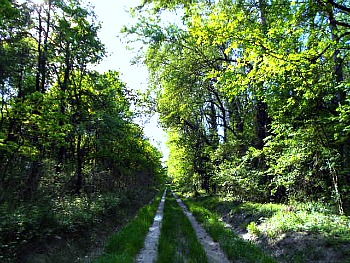
History of the Reserve
The Panfilia Woodland is a rare and precious witness of the ancient forests which used to cover the plains of the Po in ancient times – even though, strictly speaking, it is not a proper ‘relic’ woodland, as hinted by many researchers in the past.
Recent studies have in fact established that the Bosco della Panfilia only started to form itself less than three centuries ago, in close relationship with the events tied to the course of the Reno, and it is still very linked to the river, as today it is one of the most noteworthy examples of flooded forest in the Po valley.
At about half of the 15th century, the river found a steady course between Cento and Pieve di Cento (where it still flows), and then directed itself towards the Galliera valleys (Valli di Galliera) – a fact that kick started a row between the Bolognese and the Ferrarese, which would last for about four centuries: the former wanted the Reno to be deviated into the Po di Ferrara, so to ward off the risk of damaging floods and arable land being turned into marshland; the latter, on the contrary, opposed this plan in fear of the same catastrophic events (flooding and slumping of the river) becoming likely to their main watercourse to the Adriatic sea (that is, the Po di Ferrara).
In the end, the Bolognese won the contest, convincing in 1522 the Duke of Ferrara Alfonso I d’Este to carry out the necessary work: from 1530 to 1604 the Reno remained thus channeled into the Po di Ferrara, following a route from Sant’Agostino to the Po via Vigarano Mainarda and Cassana.
As a matter of fact, water from the Reno – rich in mud carried from the mountains and the hills – would not fail to cause the feared damages, and the Po di Ferrara would break out of its embankments on several occasions.
The following reorganization of the local water system would be decided by Pope Clement VIII in 1604, who took away the Reno from the Po in order to deviate it into the Sammartina valleys at Poggio Renatico, near Ferrara.
These conditions would be maintained until about 1750, when two successive interventions – imposed by the precarious hydraulic conditions of the area – would finally lead the Reno to empty out directly into the Adriatic sea, as it still does today.
Just before that, Pope Benedict XIV had the ‘Benedictine Cut’ (‘Cavo Benedettino’) being excavated, with the aim of regulating the irregular outflow of water from the Reno into the Po di Primaro valleys; after that, however, the disastrous breakout at Sant’Agostino (Rotta di Sant’Agostino) in 1750 would cause the deviation towards the east, thus supporting the new course taken by the river itself after the breakout.
This deviation would be consolidated with the realization of a connection with the ‘Cavo Benedettino’ between 1767 and 1782, and then by finally deviating the Reno into the course of a previous branch of the Po – the Po di Primaro – before reaching out into the Adriatic sea.
By the way, the infamous breakout of 1750 is the one that would damage also the palace and estate of Marquis Panfilio Facchinetti , situated by the Reno – and this is important for us.
This is in fact the reason why that event would go on to be recorded in history with the name of ‘Rotta Panfilia’ – and right on the alluvial deposit of this breakout (where the massive flood took place) an hygrophyle vegetation started to grow. This formed a woodland that would later become known as Bosco della Panfilia (Panfilia Woodland) because of this catastrophic event – hence the name retained by the reserve still to this day.
Nevertheless, even the new course did not eventually provide an end to the floods of the Reno; so, in 1807, in the hope of finding a new solution, the Emperor Napoleon I – on pressure of the Bolognese – decided the digging of another artificial canal, which was later to become known as the ‘Napoleonic Cut’ (‘Cavo Napoleonico’), with the intent of taking the water away from the Reno by the deviation at Sant’Agostino into the Panaro river (in the vicinity of Bondeno), before draining it finally into the Po (in the picture below, an image of the Reno as it crosses the reserve, tumbling down a weir).
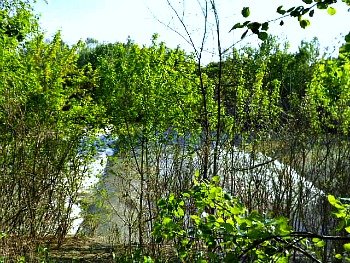
The execution of this enterprise was abandoned in 1814, only to be then taken on again and accomplished much time later – in the decade 1954-1963 – after the damaging floods of the Reno at Gallo, near Poggio Renatico, in 1949 and 1951.
The new ‘Napoleonic Cut’, 18 km long, now links directly the Reno with the Po and plays two important roles: as a floodway of the Reno during the winter months, and as irrigation canal in service of the Canale Emiliano-Romagnolo (the artificial canal that crosses through the plains of Emilia-Romagna) during the summer period.
The latter is an artificial canal that was excavated after 1956, and with a total length of 133 km it connects the ‘Napoleonic Cut’ with Romagna, as the canal empties out into the small Uso river – quite near the Adriatic sea.
The Canale Emiliano-Romagnolo is already operative, as water is derived from the Po then pumped into the ‘Napoleonic Cut’ and finally into the Canal, from where it is used for both irrigation purposes and civil use (row of columnar poplars are a typical feature of the landscape here, as they delimit the reserve – as in the picture below – but often also run along the canals for long distances).
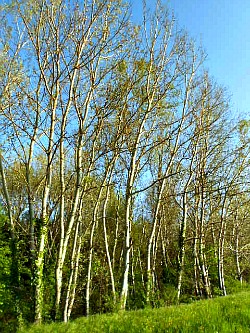
Location of the Reserve
The Panfilia Wood is situated entirely in the municipality of Sant’Agostino, in the province of Ferrara, within a wide bend of the river Reno. It has an extension of 81 hectares, thus subdivided: 50 hectares of natural wood, 28 hectares of reforestation and three main avenues crossing it (see another picture of the main avenue below) – plus a few draining canals.
It is delimited to the west by the ‘Napoleonic Cut’, to the north by the actual town of Sant’Agostino, to the east by the cultivated countryside of Poggio Renatico and to the south by the river Reno – that marks the natural boundary between the provinces of Ferrara and Bologna.
The Canale Emiliano-Romagnolo mentioned above underpasses the wood at its eastern end, as well as the river Reno itself. Given its location in a floodplain, the Bosco della Panfilia is subjected to recurrent flooding, especially on occasions when the Reno is in full flood.
The Bosco della Panfilia is part of the natural heritage of the Emilia-Romagna region. The Italian Botanic Society classified it in 1971 as ‘biotope of relevant interest for its vegetation’, and it is comprised in the regional landscape plan as an area of ‘natural protection’, for its being also the last station of the so-called Parco del Reno (a system of parks and reserves along the course of the river).
Part of this system is also the twin reserve of La Bisana – facing the Bosco della Panfilia on the opposite bank of the Reno, and instituted by the two municipalities of Pieve di Cento and Galliera.
This consisted originally of the ‘basin’ (a portion of floodplain comprised between two embankments) and a house used for hydraulic control situated in the surrounding countryside. In 1998 the area was extended on the surrounding floodplains for a total of about 35 hectares.
The project of re-naturalization of this area, suggested by the two municipalities together with WWF and with the approval of the region, has allowed to extend on the other bank the original reserve, in order to create a unique protected area along the Reno, quite coherent in terms of its typology and naturalistic values, and comprising in a single unit the territories of Ferrara and Bologna facing each other along this stretch of river.
This new situation prompted the WWF to ask for the adoption of a common strategy for the unified management of the two protected areas, so since 2002 the Bosco della Panfilia is administered jointly by the three municipalities of Sant’Agostino, Pieve di Cento and Galliera, plus the two provinces of Ferrara and Bologna, in the view of turning it eventually into a Regional Natural Reserve – an instrument that would guarantee a better level of protection and appropriate enhancement of this precious biotope.
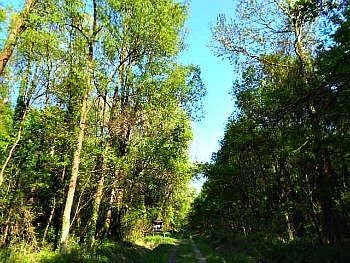
The Natural Environment
Flora
The vegetation of the Panfilia Wood is typical of the ‘wet woodlands of the Po valley’, and it is mostly constituted of species that can withstand high levels of humidity and water during the seasonal flood events.
In the section of natural woodland to the left of the main avenue (pictured above) – even though the structure is not uniform – one can distinguish:
– A dominant plane of tall trees, with an average height between 20 and 30 metres, predominantly represented by Oak (Quercus robur), White Poplar (Populus alba), Ash (Fraxinus excelsior) and White Willow (Salix alba). Locust (Robinia pseudoacacia) – although an invasive species at times – is dominant in some parts of the wood with decent specimens, reaching quite impressive heights too.
– A dominated plane – or lower tree-level – follows, with Small-leaved Elm (Ulmus minor; still present although damaged by the Dutch elm disease), Field Maple (Acer campestre) and Manna ash (Fraxinus ornus), plus some specimens of Black Poplar (Populus nigra), White Mulberry (Morus alba) and Black Alder (Alnus glutinosa).
– A rich bush level follows, with Blackthorn (Prunus spinosa), Hazelnut (Corylus avellana), Hawthorn (Crataegus monogyna), Common Elder (Sambucus nigra), Privet (Ligustrum vulgare), False Indigo-Bush (Amorpha fruticosa), Buckthorn (Frangula alnus), Dogwood (Cornus sanguinea) and Cornelian Cherry (C. mas) – all present especially on the wood fringes.
– An understory level has to be added to this, which is dominated by tufts of a coarse grass (Carex sp.) in the most internal, shaded and damp locations subject to flood, and, in a lesser way, by Bramble (Rubus fruticosus agg.) along the trails and avenues, and in general in the areas more exposed to the sunlight.
Among the creepers, which are present especially in the area of the central basin (that is not subject to flooding by the river Reno, as it is protected by embankments), one can find with more frequency common species such as Ivy (Hedera helix), Traveler’s Joy (Clematis vitalba) and Purple Clematis (Clematis viticella).
As for the climbers, one has to be reminded also of the presence of common Hops (Humulus lupulus) and White Bryony (Bryonia dioica). The section to the right of the main avenue and closer to the river, which was reforested since 1983, is currently growing, and it also hosts mainly oak, white poplar, ash and white willow – that is, all local species of trees already listed above.
Along the banks of the Reno grows a thick riverside vegetation constituted mainly of White Willow (Salix alba), Osier (Salix viminalis) and Purple Willow (Salix purpurea).
– The herbaceous layer is decidedly characterized by a poor contingent of plants, as this is a very shaded environment also subject to periodic river floods. Nevertheless, the spring and summer blossoming of many local spontaneous species is quite abundant along the paths and avenues, and also along the most external embankments, which are decidedly sunnier, with pleasant effects (see picture below).
The fascination of a rare habitat such as woodlands on a plain and the presence of a network of easy paths are all factors that contribute to an unusual environment that makes for a pleasant visit; thanks to its flatness, the reserve is also a suitable location for everyone.
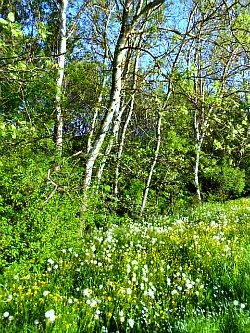
Mushrooms
In the reserve are present many species of mushrooms and toadstools – either epigenetic as well as some species of hypogeal fungi.
As for the epigenetic mushrooms, the mychorryzal fungi are less common, while species connected to wood abound (parasite and saprophyte – that is, species that feed on rotting wood).
Among the edible species, one can find many belonging to the genus Morchella as well as many others, which can generally be seen at the wood margins.
Numerous mushrooms belong to the family of the Polyporaceae and Agaricaceae; among these, many are those thriving on wood too, and most of them will be inedible species. Present are also fungi from the genera Pholiota, Auricularia, Lentinus – as well as the Mixomiceta.
Mushroom-picking – still a favourite pastime in Italy – is possible here, but a permit will have to be obtained beforehand (as in most of the country). It is possible to bump into poisonous species such as the infamous Amanita phalloides – so a word of warning is necessary.
Hypogeal (subterranean) mushrooms were once a lot more abundant than they are now; currently it is a lot more difficult to find them, probably as a consequence of environmental pollution.
Amongst these fungi are to be counted the truffles: the type considered more precious is the so-called white truffle, or Tuber magnatum. Two species of black truffles are also present – and especially noteworthy is Tuber macrosporum.
Fauna
Birds represent the main fauna within the reserve, either for resident as well as for migrating species. Many of them nest here, and amongst these are Blackbird, Jay, Starling, Blue and Great Tit, Wren, Skylark, Siskin, Rooks, Chaffinch, Greenfinch, Golden Oriole, Cuckoo, Red woodpecker, Wryneck and others. Wood pigeon is passing through during the autumn.
Other species are more connected with the wetlands and humid habitats by the Reno and nearby ‘Napoleonic Cut’, where we can find River Nightingale, Kingfisher, Moorhen, Germander (wild duck), Grey Heron and Coot. Egret and Common Seagull can be more easily noticed when the river floods the area, and its water invades the woodland.
The most common bird in the undergrowth is undoubtedly Pheasant, which can easily be spotted in the surrounding cultivated fields too, which limit the reserve to the north (see an image below). Birds of prey are also present; amongst them are to be counted some night-time species such as Tawny-, Barn- and Eagle Owl that easily find shelter in the old dilapidated farmhouses. Amongst the day-time birds of prey are Buzzard, Sparrow-hawk and Osprey.
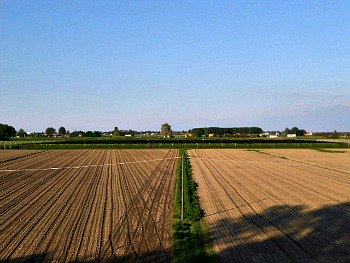
As for the mammals Hare, Hedgehog and Mole are present, together with several micro-mammals; even Fox (which is not a pest in Italy) has made its appearance in the wood margins. Coypu is present both in the ‘Napoleonic Cut’ and in the river Reno, and its presence is problematic.
Among the amphibians that find in the woodland an area in which to thrive we can often see Tree Frog, Dalmatian Frog and Toad. Reptiles are represented by Green Lizard, Common Lizard, Rat-snake, Blind-worm, Water Turtle and Collar’s Natrix.
The presence of some Vipers is not to be ruled out completely, even though that would be a rather rare encounter, considering that these areas do not constitute its preferred natural habitat (they are too humid).
At last, there are also some species of invertebrates: these are quite numerous in the woodland, and their presence is a common occurrence – so they are relatively easy to spot; amongst these are to be counted snails and slugs, spiders, several butterflies, dragonflies, grasshoppers, crickets, fireflies, ladybugs and bees.
Of particular scientific interest are the Carabida beetles (such as Carabus granulatus interstitialis, Phonias ovoideus mainardii and Atranus collaris); these are all insects linked to the soil, as they live at ground level. Sometimes they are also important environmental indicators, and have therefore been the object of study by the Museum of Natural Sciences of Ferrara.
It goes without saying that hunting is not permitted in the reserve.
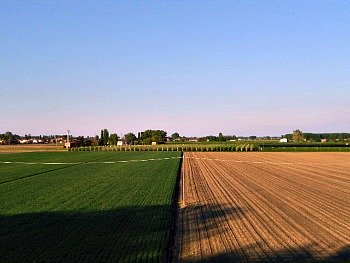
How to Visit the Reserve
Visits to the Panfilia Wood are possible at any time of the year, as entry to the reserve is free and not regulated; for safety reason and a more enjoyable visit, however, it is advised to avoid the periods after heavy rain or snowfall, or during and after the floods of the Reno, when thick mud make walking quite a challenging enterprise – apart from the elevated embankments above the catino (from where was taken the picture above), which always remain dry; summer is also not the best season to visit, as the Po valley has a very hot and humid climate and the area can therefore be easily infested with mosquitoes.
Be mindful, also, that inside the reserve there are no equipped areas for eating or drinking, so you should come with a water bottle, appropriate footwear and waterproof gear – as well as a good pair of binoculars for bird watching.
The main avenues can be either walked, cycled or horse-ridden; the smaller trails (especially those along the canals), on the contrary, can only be walked on foot. A rather exhaustive visit will take about 2 to 3 hours – but consider more if you are willing to be taken away by the magic of the place, especially on a nice spring’s afternoon.
The best seasons for visiting the reserve are undoubtedly spring and autumn, while the best times of day are either morning or late afternoon, when the aquatic birds lull you with their concert before nighttime.
I particularly like to come to the Panfilia when some parts of the lower woods (in the so-called catino) are still flooded, but it is safe enough to walk: it is then like finding oneself in a small version of the Everglades – but equally fascinating!
Return from Panfilia to italy-tours-in-nature
Copyright © 2010 Italy-Tours-in-Nature

New! Comments
Have your say about what you just read! Leave me a comment in the box below.